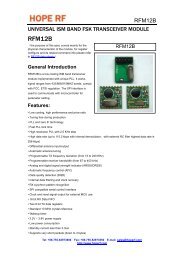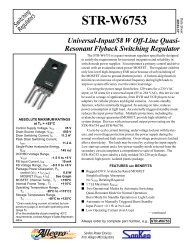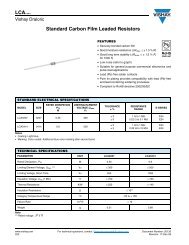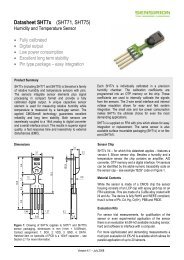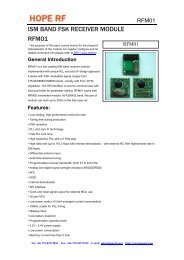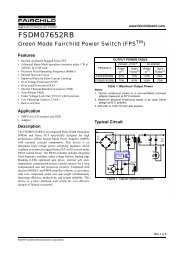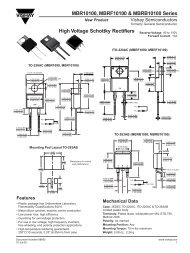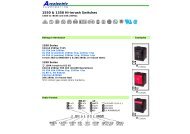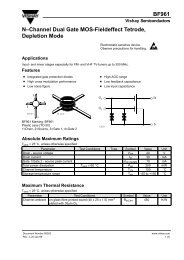LM3886 High-Performance 68W Audio Power Amplifier w Mute
LM3886 High-Performance 68W Audio Power Amplifier w Mute
LM3886 High-Performance 68W Audio Power Amplifier w Mute
You also want an ePaper? Increase the reach of your titles
YUMPU automatically turns print PDFs into web optimized ePapers that Google loves.
Application Information (Continued)<br />
A thermal grease such as Wakefield type 120 or Thermalloy<br />
Thermacote should be used when mounting the package to<br />
the heat sink Without this compound thermal resistance<br />
will be no better than 05CW and probably much worse<br />
With the compound thermal resistance will be 02CW or<br />
less assuming under 0005 inch combined flatness runout<br />
for the package and heat sink Proper torquing of the<br />
mounting bolts is important and can be determined from<br />
heat sink manufacturer’s specification sheets<br />
Should it be necessary to isolate V b from the heat sink an<br />
insulating washer is required Hard washers like beryluum<br />
oxide anodized aluminum and mica require the use of thermal<br />
compound on both faces Two-mil mica washers are<br />
most common giving about 04CW interface resistance<br />
with the compound<br />
Silicone-rubber washers are also available A 05CW thermal<br />
resistance is claimed without thermal compound Experience<br />
has shown that these rubber washers deteriorate and<br />
must be replaced should the IC be dismounted<br />
Determining Maximum <strong>Power</strong> Dissipation<br />
<strong>Power</strong> dissipation within the integrated circuit package is a<br />
very important parameter requiring a thorough understanding<br />
if optimum power output is to be obtained An incorrect<br />
maximum power dissipation (P D ) calculation may result in<br />
inadequate heat sinking causing thermal shutdown circuitry<br />
to operate and limit the output power<br />
The following equations can be used to acccurately calculate<br />
the maximum and average integrated circuit power dissipation<br />
for your amplifier design given the supply voltage<br />
rated load and output power These equations can be directly<br />
applied to the <strong>Power</strong> Dissipation vs Output <strong>Power</strong><br />
curves in the Typical <strong>Performance</strong> Characteristics section<br />
Equation (1) exemplifies the maximum power dissipation of<br />
the IC and equations (2) and (3) exemplify the average IC<br />
power dissipation expressed in different forms<br />
P DMAX e V CC<br />
22q2R L (1)<br />
where V CC is the total supply voltage<br />
P DAVE e (V Opk R L )V CC q b V Opk 2 (2)<br />
where V CC is the total supply voltage and V Opk e V CC q<br />
P DAVE e V CC V Opk qR L b V Opk<br />
22R L (3)<br />
where V CC is the total supply voltage<br />
Determining the Correct Heat Sink<br />
Once the maximum IC power dissipation is known for a given<br />
supply voltage rated load and the desired rated output<br />
power the maximum thermal resistance (in CW) of a heat<br />
sink can be calculated This calculation is made using equation<br />
(4) and is based on the fact that thermal heat flow parameters<br />
are analogous to electrical current flow properties<br />
It is also known that typically the thermal resistance i JC<br />
(junction to case) of the <strong>LM3886</strong> is 1CW and that using<br />
Thermalloy Thermacote thermal compound provides a thermal<br />
resistance i CS (case to heat sink) of about 02CW<br />
as explained in the Heat Sinking section<br />
Referring to the figure below it is seen that the thermal<br />
resistance from the die (junction) to the outside air (ambient)<br />
is a combination of three thermal resistances two of which<br />
are known i JC and i CS Since convection heat flow (power<br />
dissipation) is analogous to current flow thermal resistance<br />
is analogous to electrical resistance and temperature drops<br />
are analogous to voltage drops the power dissipation out of<br />
the <strong>LM3886</strong> is equal to the following<br />
P DMAX e (T Jmax b T Amb )i JA<br />
where i JA e i JC a i CS a i SA<br />
TLH11833–12<br />
But since we know P DMAX i JC and i SC for the application<br />
and we are looking for i SA we have the following<br />
i SA e (T Jmax b T Amb ) b P DMAX (i JC a i CS )P DMAX (4)<br />
Again it must be noted that the value of i SA is dependent<br />
upon the system designer’s amplifier application and its corresponding<br />
parameters as described previously If the ambient<br />
temperature that the audio amplifier is to be working<br />
under is higher than the normal 25C then the thermal resistance<br />
for the heat sink given all other things are equal<br />
will need to be smaller<br />
Equations (1) and (4) are the only equations needed in the<br />
determination of the maximum heat sink thermal resistance<br />
This is of course given that the system designer knows the<br />
required supply voltages to drive his rated load at a particular<br />
power output level and the parameters provided by the<br />
semiconductor manufacturer These parameters are the<br />
junction to case thermal resistance i JC T Jmax e 150C<br />
and the recommended Thermalloy Thermacote thermal<br />
compound resistance i CS <br />
12



